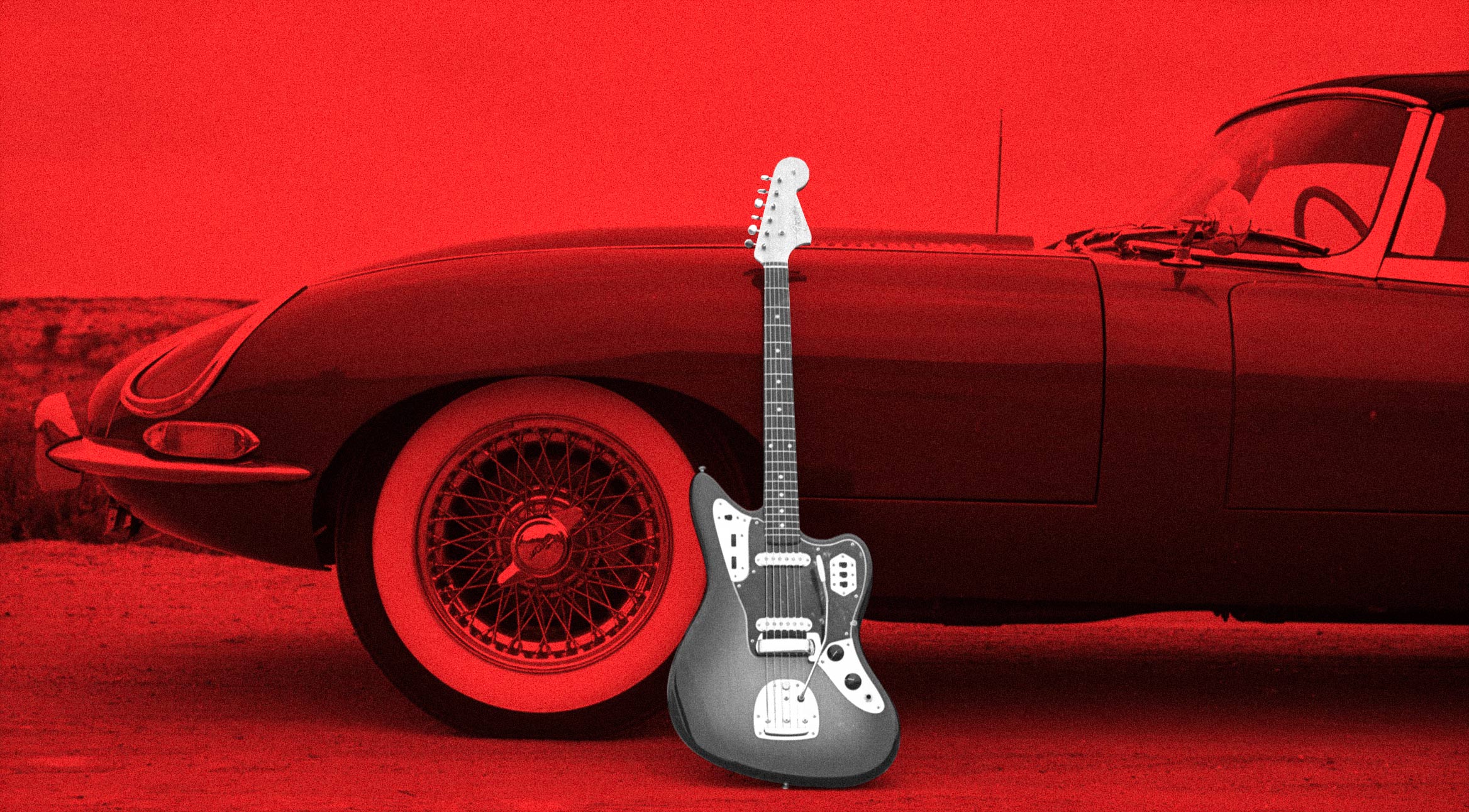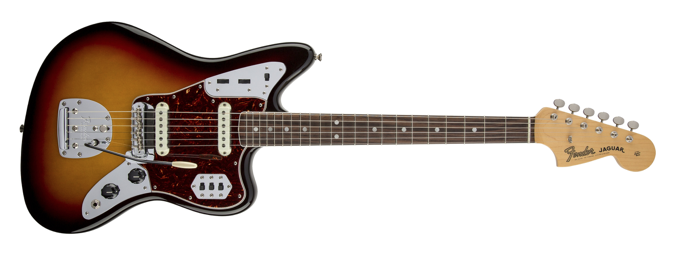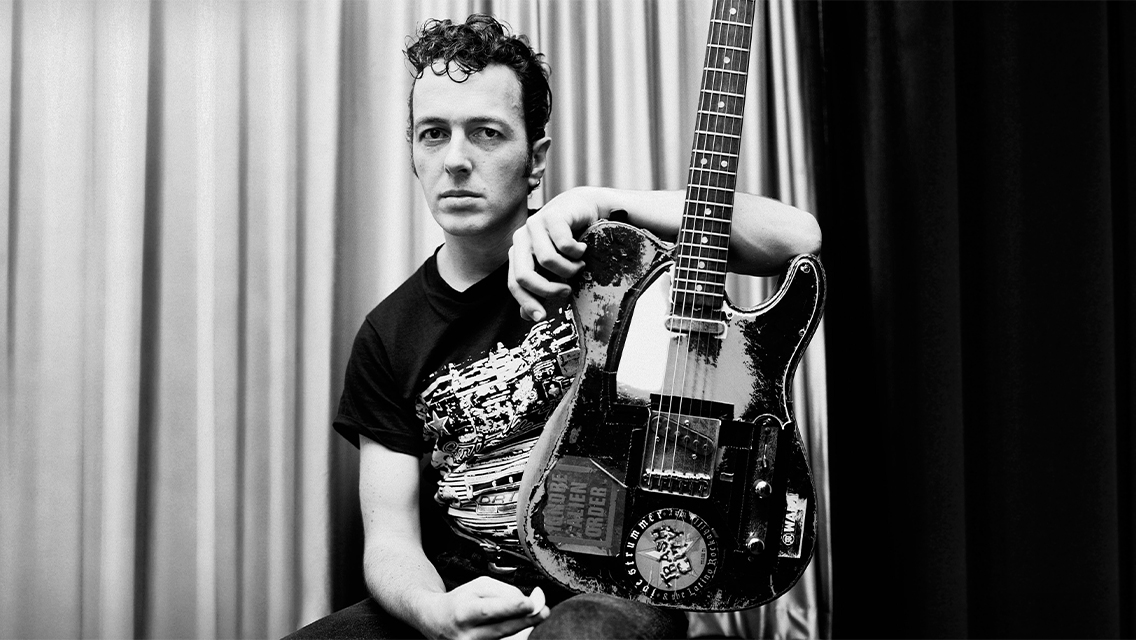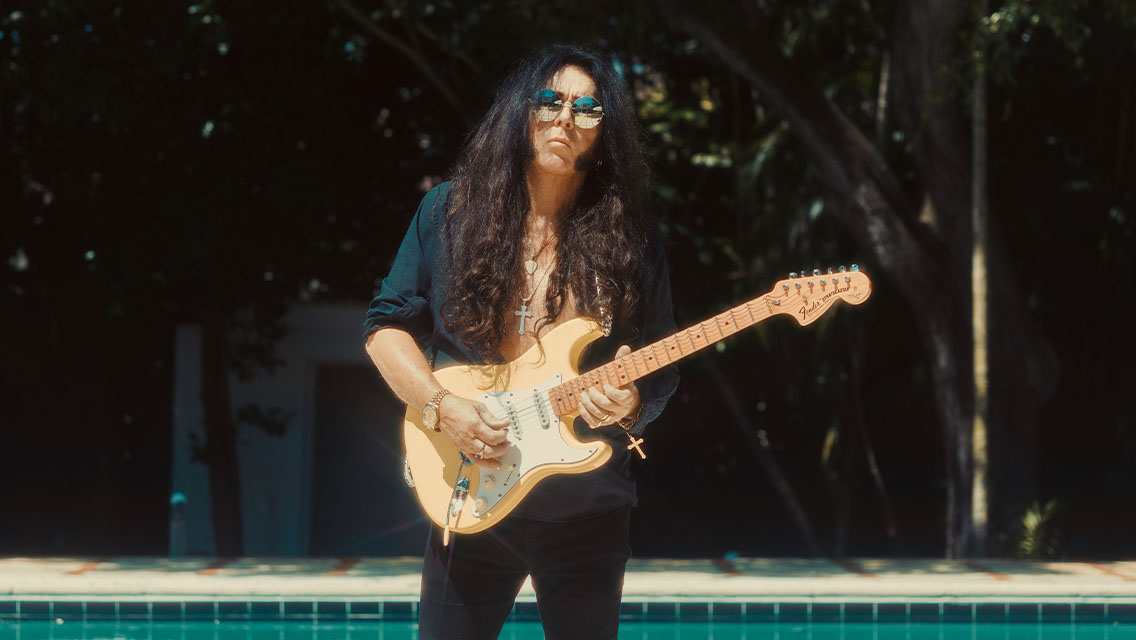12 Min ReadBy Jeff Owens
From Surf to Shoegaze, a History of the Jaguar
How Fender’s “high-end” original went from forgotten to fundamental.

THE RUNDOWN
Fender introduced the Jaguar guitar in 1962 as the fourth and last instrument in its original standard guitar lineup. Preceded by the Telecaster (1951), the Stratocaster (1954) and the Jazzmaster (1958), the Jaguar was the only one of Fender’s big-four guitars born in the 1960s, and it was in several ways the most distinctive among them.
Introduced as Fender's high-end model, the Jaguar was initially adopted by surf guitarists just as that fad was running out of wave. Jaguars everywhere began collecting dust until the punk explosion of the '70s and its subsequent mutations took it from relic to iconic.
THE GUITAR
The Jaguar had 22 frets and a significantly shorter 24-inch scale length, which was deliberately closer to the standard Gibson scale length of 24.75-inches rather than the standard 25.5-inch Fender scale length of the 21-fret Telecaster, Stratocaster and Jazzmaster. The Jaguar’s shorter scale and extra fret made for what Fender billed as “faster, more comfortable” playing.
Its relatively smaller size notwithstanding, the Jaguar was indeed billed as Fender’s new top-line guitar and was nothing if not feature laden. It had an offset body—distinct from the Jazzmaster’s offset shape—and featured separate bridge and floating vibrato units. And if the Jaguar’s distinctive shorter scale length and extra fret weren’t all that obvious on first glance, the sheer amount of chrome and controls were.

The Jaguar had the most elaborate circuitry of any Fender instrument. Although it and the Jazzmaster were dual-circuit guitars (lead and rhythm), the Jaguar’s lead circuit was more complex, with three slide switches on a chrome plate on the lower horn (compared to the Jazzmaster’s single toggle switch). The first two were on-off switches for each pickup; the third engaged a capacitor that served as a low-end filter, producing a more cutting treble tone (informally known as the “strangle” switch). The Jaguar’s rhythm circuit consisted of a single slide switch on the upper horn that delivered a more bass-heavy neck-pickup-only sound, with its own adjacent volume and inset tone wheels (all mounted to, of course, a chrome plate).
The Jaguar had tall, narrow, high-output pickups that were surrounded by notched metal rings (“claws”) that reduced hum and concentrated the magnetic field beneath the strings, an unusual feature not found on any other Fender instrument except 1961’s Bass VI.
The Jaguar was also the first Fender guitar to be offered with a variety of neck widths. Four options were designated A, B, C and D from narrowest to widest—standard, slightly narrower than standard, and two wider than standard. These options were also made available on the Stratocaster and Jazzmaster from 1962 on.
Finally, the introduction of the Jaguar marked the first appearance of a new Fender headstock logo known as the “transition” logo, so named because it bridged the gap between the the company’s original spaghetti logo and the heavy black logo adopted at the end of the 1960s.
THE PLAYERS
Too many to mention, but here are some highlights:
Tom Verlaine (Television)
John Frusciante (Red Hot Chili Peppers)
Thurston Moore (Sonic Youth)
John Squire (Stone Roses)
Kevin Shields and Bilinda Butcher (My Bloody Valentine)
Billy Corgan (Smashing Pumpkins)
Ira Kaplan (Yo La Tengo)
Graham Coxon (Blur)
Johnny Marr (Smiths, The The, Modest Mouse)
Mark Gardener (Ride)
Will Sergeant (Echo & the Bunnymen)
Blixa Bargeld (Einstürzende Neubauten, Nick Cave and the Bad Seeds)
James Johnston (Gallon Drunk, Nick Cave and the Bad Seeds)
Troy Van Leeuwen (A Perfect Circle, Queens of the Stone Age)
Win Butler (Arcade Fire)
PJ Harvey
Brian Molko (Placebo)
Bradford Cox and Lockett Pundt (Deerhunter)
Jonny Buckland (Coldplay)
Jeff Wooton (Gorillaz)
THE FULL STORY
The Telecaster and the Stratocaster both were unqualified and ubiquitous successes by 1962, and the Jazzmaster had by then embarked on its own unusual odyssey quite apart from its original intended role as Fender’s top guitar. More than the first two guitars, in fact, the Jaguar owed much to the Jazzmaster, which, despite lofty expectations, was immediately dismissed by the East Coast hollow-body jazz cats Fender aimed it at, only to find itself early in the next decade the darling of West Coast surf and instrumental rock groups whose reverb-drenched hits crested the charts between Kennedy’s election and the arrival of the British.
Fender had also spent the 1950s playing David to Gibson’s Goliath in a remarkable game of design one-upmanship that gave the world several of its most enduringly acclaimed and successful electric guitar models. And the new top-line guitar model that Fender was preparing to unveil in 1962 included a major design departure specifically intended to appeal to Gibson players—a short scale.
With hindsight it might seem curious that early-’60s Fender clung so tenaciously to the idea of a feature-laden “high-end” guitar. It had already scored its greatest successes with four innovative workhorse instruments (two guitars and two basses) remarkable for being elegantly and ingeniously simple rather than complex. Even so, Fender seemed convinced at the time that a more elaborate guitar design was the way forward in a bold new decade when incredible technological advances seemed like daily occurrences.
And the Jaguar was nothing if not feature laden. A beautiful guitar, it had a Jazzmaster-like offset body (the two weren’t identical—the Jaguar’s upper horn was and still is sharper than the Jazzmaster’s), and like the Jazzmaster it had separate bridge and floating vibrato units. And if the Jaguar’s distinctive shorter scale length and extra fret weren’t all that obvious on first glance, the sheer amount of chrome and controls were.

Certainly, the Jaguar was the most blindingly chromed-out instrument in the Fender lineup, with three gleaming control plates in addition to the chrome bridge, vibrato tailpiece, tremolo arm and pickup rings (more about them shortly). Gazing directly at it almost required sunglasses. And the Jaguar eclipsed even the Jazzmaster in number of onboard controls; the former with eight (four switches, two knobs and two inset wheels) compared to the latter’s six (two switches, two knobs and two inset wheels).
The Jaguar also had significantly different pickups than the Jazzmaster, which had big, wide single-coil pickups that sounded smooth and thick but were also highly susceptible to unwanted electrical hum because they were unshielded. The Jaguar had taller, narrower Strat-like high-output pickups that sounded much hotter. Further, Jaguar pickups were surrounded by notched metal rings (“claws”) that reduced hum and concentrated the magnetic field beneath the strings, an unusual feature not found on any other Fender instrument except 1961’s Bass VI.
With more controls than any other Fender instrument, the Jaguar had the most elaborate circuitry of any Fender instrument. Although it and the Jazzmaster were dual-circuit guitars (lead and rhythm), the Jaguar’s lead circuit was more complex, with three slide switches on a chrome plate on the lower horn (compared to the Jazzmaster’s single toggle switch). The first two were on-off switches for each pickup; the third engaged a capacitor that served as a low-end filter, producing a more cutting treble tone (informally known as the “strangle” switch). The Jaguar’s rhythm circuit consisted of a single slide switch on the upper horn that delivered a more bass-heavy neck-pickup-only sound, with its own adjacent volume and inset tone wheels (all mounted to, of course, a chrome plate).
In designing the Jaguar, Fender still clung to onboard string-muting mechanisms, as found on earlier instruments such as the Jazz Bass (1960) and Bass VI. The spring-operated mute on the Jaguar’s bridge was nonetheless largely ignored, as most guitarists favored manual muting techniques.
The Jaguar was also the first Fender guitar to be offered with a variety of neck widths. Four options were designated A, B, C and D from narrowest to widest—standard, slightly narrower than standard, and two wider than standard. These options were also made available on the Stratocaster and Jazzmaster from 1962 on.
Finally, the introduction of the Jaguar marked the first appearance of a new Fender headstock logo. Fender used its original thin “spaghetti” logo throughout the 1950s until Robert Perine, the adman who created Fender’s stylish late-’50s and 1960s advertising look (including the famous “You won’t part with yours either” campaign), designed a thicker version of it eventually known as the “transition” logo, so named because it bridged the gap between the spaghetti logo and the heavy black logo adopted at the end of the 1960s. Perine’s new Fender logo began appearing in print ads around 1960, and Fender eventually adopted it as a headstock logo—starting with the Jaguar.
The Jaguar enjoyed mild popularity on its introduction—Beach Boy Carl Wilson occasionally played one during the mid-’60s, and Jimi Hendrix received a ’63 model as a gift from Rolling Stones guitarist Brian Jones. Several other lesser-known guitarists favored the Jaguar during the model’s first years, including Eddie Bertrand, Dave Myers, Mary Kaye, Kathy Marshall, Paul Guma, Roy Lanham and Bye Bye Birdie star Jesse Pearson, who played a custom black Jaguar with gold-plated hardware and a gold-leaf scroll design on the body.
Carl Wilson of the Beach Boys plays his Jaguar during the opening credits of the movie The Monkey's Uncle starring Anette Funnicello:
But given the still-increasing dominance of the both the Telecaster and Stratocaster, and with the British Invasion of 1964 all but wiping out surf music as a charting entity, the Jaguar (much like the Jazzmaster) soon found itself relegated to secondary status. Sales were healthy enough to keep it in the Fender line well into the 1970s, though, and the Jaguar enjoyed a 13-year run before CBS-era Fender discontinued it in 1975.
Interesting, though, that production of the guitar should cease just on the eve of the detonation of a volatile new musical movement that would endow the now bargain-basement instrument with a new lease on life, increasing popularity and with a potent measure of fashionable street cred.
Punk hit big in 1976 in London and New York. And while the real thing flamed out almost as soon as it started, punk had seismic effects that continue to reverberate throughout popular music and culture. While many punks simply couldn’t afford a Telecaster or Stratocaster, the dust-covered Jaguars that had sat ignored in darkened retail corners for years were practically a steal. Punk and its subsequent mutations resurrected the Jaguar.
At the same time, Fender itself was struggling more and more under the corner- and cost-cutting rule of parent company CBS. Quality control had deteriorated significantly by the late 1970s and early 1980s, dragging popular opinion down with it.
Appointed in 1981, new Fender president William Schultz eagerly set about reversing the company’s ailing fortunes. He immediately recommended modernizing Fender’s U.S. manufacturing facilities, which largely meant halting production while machinery was updated and staff was re-trained. In the meantime he suggested building Fender instruments in Japan for that nation’s vigorous market, which would keep Fender guitars and basses in production and combat the cheap copies that were voraciously eating away at Fender’s Far East sales.
Fender Japan was established in March 1982. It began producing instruments widely praised for their quality and authenticity during the unsteady years while U.S production was reorganized, and it soon began building instruments for the European and U.S. markets under both the Fender and Squier names. Fender Japan resurrected the Jaguar (and the Jazzmaster) after CBS sold Fender to Schultz in 1985, and has continued to build high-quality reissue Jaguar models ever since.
While Jaguar production resumed in Japan, punk’s far-reaching and fast-mutating effects continued to resound throughout the ’80s and into the ’90s, and a whole new generation of Jaguar-wielding guitarists who’d come of age with punk came to the fore. Perhaps most prominent among them was Kurt Cobain, an anti-hero’s anti-hero who often slung a left-handed 1965 Jaguar during Nirvana’s intense and meteoric early-’90s reign, nearly singlehandedly transforming alternative rock from small niche market to major worldwide musical, cultural and commercial phenomenon.
Kurt Cobain plays his '65 Jaguar during a '91 Nirvana performance of 'Lithium':
Cobain’s use of the Jaguar spurred it to even greater revived popularity, and he himself played a central role in the design of a hybrid instrument, the Jag-Stang, which Fender introduced in 1995—a year after Cobain’s untimely passing. A FrankenFender combining a Jaguar and a Mustang, the Japanese-built Jag-Stang stayed in the Fender line through the remainder of the decade.
Inspired by Bush vocalist Gavin Rossdale, who had a Jaguar modified with dual humbucking pickups, Squier joined the Jaguar fold in the mid-1990s by combining it with the Jazzmaster to create the Jagmaster. The guitar debuted in 1997 as part of the Japanese-built Vista Series and was offered through the following year.
Kurt Cobain’s preference for the Jaguar in the early 1990s dramatically underscores the fact that the Jaguar has proven far more popular in the modern era than it ever did during the 1960s and early ’70s, and the renewed popularity prompted the revitalized modern-era Fender to resume domestic production of the guitar, which it did in 1999. That year’s American Vintage series ’62 Jaguar was the first U.S.-made Jaguar model in nearly 25 years and won acclaim as the return of a classic.
A concentrated burst of Jaguar activity took place in the early and mid-2000s. The Squier Jagmaster reappeared in May 2000, this time made in China and featuring a standard Fender 25.5-inch scale length. The Kurt Cobain-inspired Fender Jag-stang was revived from 2003 to 2005, and several interesting and innovative takes on the Jaguar appeared from 2004 to 2006 that complemented the continuing success of the American Vintage ’62 Jaguar. These included the Japanese-built Antigua Jaguar, Jaguar Baritone Custom, Special Edition Jaguar HH and Jaguar Baritone Special HH, and the Special Edition Jaguar Bass VI Custom. Squier’s Jagmaster was revised substantially in 2004, including a return to the classic Jaguar 24” scale length.
Another mid-decade development was Fender’s highly successful Jaguar Bass (2006), which was essentially a Jazz Bass dressed up in Jaguar form, with additional Jaguar-inspired electronics that gave it remarkable tonal versatility.
The Fender Classic Player series Jaguar Special and Jaguar Special HH models, built in Mexico, appeared in 2009, and the high-output Blacktop Jaguar HH was released in 2010. On the eve of the guitar’s 50th anniversary, in 2011, Fender unveiled the Modern Player Jaguar—an affordable stripped-down model with highly distinctive features including a sans-pickguard mahogany body, specially designed single-coil pickups, three-way toggle switching, Jazz Bass-style control knobs and a vintage-style Adjusto-Matic bridge with an anchored tailpiece. Also in 2011, Squier introduced its first take on the traditional Jaguar design, the dual-humbucking-pickup-equipped Vintage Modified Jaguar HH.
One of Fender’s biggest events of 2011, however, was a tribute to the enigmatic figure who did so much to revive the Jaguar’s popularity. That fall, on the 20th anniversary of Nirvana’s colossal 1991 album Nevermind, Fender introduced the Kurt Cobain Jaguar, a meticulous recreation of the late guitarist’s battered, highly modified 1965 Jaguar in left- and right-handed versions (Cobain was left-handed). An authentic reproduction crafted to the smallest detail, it mimicked the orginal instrument’s worn finish and hardware, dual aftermarket humbucking pickups, unusual electronics and switching (including three control knobs rather than the usual two), 1950s-style “spaghetti” logo, black chrome Adjusto-Matic bridge and more. Fender even commissioned a limited-edition commemorative book to go with the guitar.
Johnny Marr plays his Signature Jaguar during a live set for Fender Films:
After half a century of surprising fortune the Jaguar turned 50 in 2012. Released early that year were the Johnny Marr Jaguar and the Blacktop Jaguar 90. The former bears several personal design refinements by Marr, the acclaimed U.K. guitar master best known for his 1980s stint as resident musical genius behind the Smiths and for subsequent stints with The The, Electronic, Modest Mouse and others. The latter, an addition to the Blacktop family, is distinguished by specially designed single-coil pickups, three-way toggle switching and skirted black amp knobs.
Chief among the three new models, however, was the 50th Anniversary Jaguar, a beautifully crafted U.S.-built model combining vintage and new features into the finest of all Jaguar guitars. The classic features are all there—the sleek shape, the 24” scale length, the notched metal pickup claws, the gleaming wealth of chrome and controls, and even the return of seldom-seen original-era Burgundy Mist finish (here called Burgundy Mist Metallic). Yet there are elegant modern touches and refinements, too—block fingerboard inlays, a new neck-angle-pocket cut for improved pitch, a re-positioned tremolo plate for increased bridge break angle and sustain, and specially designed single-coil pickups producing thicker tone and hotter output.
In many ways, the Jaguar turned out to be “the little guitar that could.” Unlike the Telecaster, the Stratocaster, the Precision Bass and the Jazz Bass, it faced a difficult climb toward enduring longevity, ultimately traveling a fascinating path impossible to predict and certainly never imagined by anyone during its original era. Like the Jazzmaster, the Jaguar survived adversity to emerge not only intact, but also better and more popular than ever.
From the vantage point of its 50th anniversary in 2012, the Jaguar has prevailed in surprising ways, having weathered the doldrums of commercial indifference in its youth to achieve unexpected glory when it turned out that history had other plans for it.
Guitarists worldwide at all levels who appreciate the road less traveled continue to prize it for its striking design and subversive personality, and it remains one of the four great members of Fender’s original standard guitar family.
Don’t miss out!
Be the first to know about new products, featured content, exclusive offers and giveaways.


